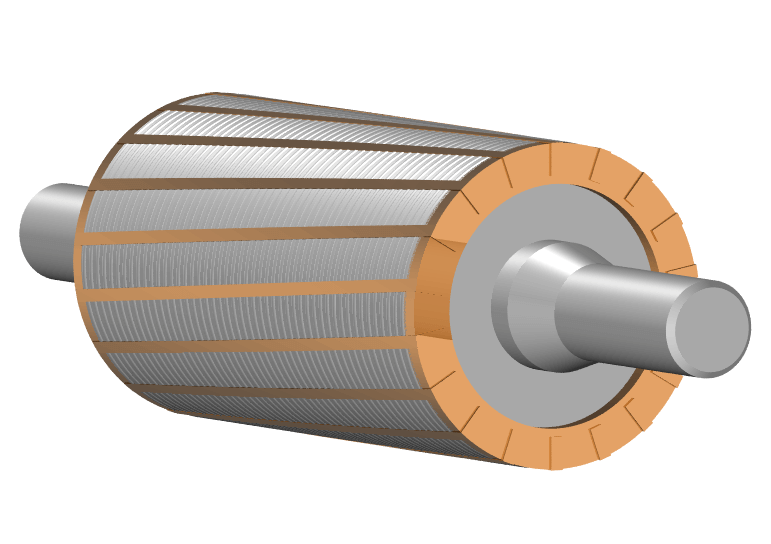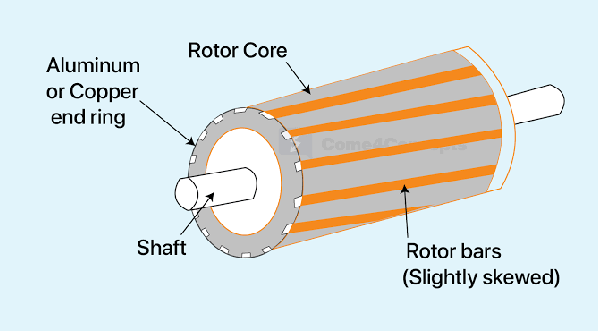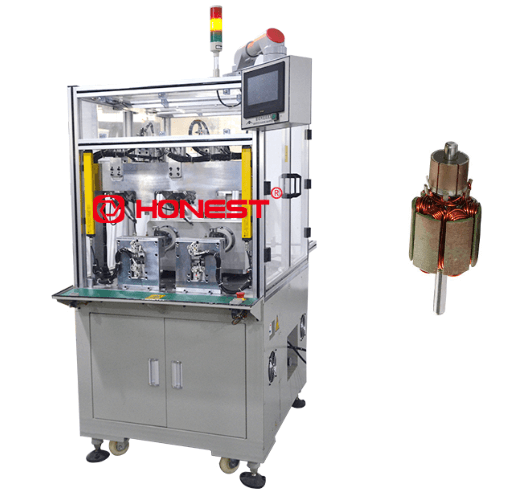
News Center
Fully Automatic Armature Winding Machine Advantages
Published on.
2024-09-19 17:08
Source
A. What is an Armature?
The first armature was used by the magnet keepers in the 19th century. It is the component of an electric motor that carries the windings through which current flows. The armature experiences relative motion concerning the magnetic field. It can be either the rotating or the stationary part of a machine. The armature plays a pivotal role in the conversion of mechanical energy to electrical energy and vice versa within the motor. In generators, it is the component that generates electromotive force (EMF), such as the rotor in a DC generator or the stator in an AC generator. In motors, it is the component that produces electromagnetic force, like the rotor in a DC motor.
B. Composition of the Armature
The armature primarily consists of four parts: the core, the winding, the commutator, and the shaft.

1. Armature Core: The armature core is the central part of the armature, typically made up of many silicon steel laminations stacked together to reduce hysteresis and eddy current losses, thereby increasing the efficiency of the motor.
2. Armature Winding: This is the winding made of conductors, which are wound into coils and placed into the slots of the armature core according to a specific pattern.
3. Commutator: Comprising many commutator segments, each segment is connected to one of the armature winding coils. The function of the commutator is to change the direction of the current continuously as the motor rotates, through contact with brushes, allowing the motor to spin continuously. It ensures that the motor can operate continuously without stopping or reversing due to incorrect current direction.
4. Shaft: The shaft is the rotating part of the motor, with the armature core and winding fixed onto it. It is usually supported by bearings in the stator part of the motor and connected to external loads through couplings or other mechanical devices.
These components work together to ensure that the motor operates efficiently and stably.
C. What is an Armature Winding?
The armature winding is a core component of an electric motor, consisting of a certain number of armature coils connected in a specific pattern. Its function is to generate current in the motor's armature, which interacts with the motor's magnetic field to produce torque, causing the motor to rotate.
The types and designs of armature windings depend on the type of motor, including direct current (DC) motors and alternating current (AC) motors:
1. Direct Current (DC) Motors: In DC motors, the armature winding is typically located on the rotor and connected to the external circuit through a commutator. The commutator's role is to change the direction of the current in time with the rotation of the rotor to maintain continuous torque and smooth operation of the motor. The armature winding of a DC motor usually has winding methods such as single-layer winding, wave winding, and lap winding.
2. Alternating Current (AC) Motors: In synchronous motors, the armature winding is usually located on the rotor, while the stator has a three-phase winding that produces a rotating magnetic field. In induction motors, the three-phase winding that generates the rotating magnetic field is actually on the stator, and the rotor can be of the squirrel-cage type or wound type. The squirrel-cage rotor is made up of short-circuited copper bars and end rings, while the wound rotor contains wound coils that may be connected to the external circuit through slip rings.
The design, number of turns, winding method, and other factors of the armature winding have a significant impact on the motor's performance, such as efficiency, power, torque, speed, and thermal management. When designing a motor, it is necessary to consider its operating conditions, production costs, and other factors to ensure the overall performance of the motor.
D. How Does the Number of Turns of the Armature Winding Affect the Performance of the Motor?
The number of turns in the winding coil, as part of the motor's stator circuit, directly determines the motor's inductance. Inductance is one of the key indicators of motor performance, affecting the current distribution and magnetic flux density within the motor. When the number of turns in the winding coil increases, the inductance increases, enhancing the motor's resistance to current flow, and thereby limiting the increase in current. Conversely, if the number of turns in the winding coil decreases, the inductance decreases, reducing the motor's resistance to current, which can lead to an easier increase in current.
For low-power motors, the winding wire is thinner and has more turns, typically with one phase of the winding having one to two thousand turns. In this case, missing a few turns during winding has a relatively minor impact on the motor's performance. However, for high-power motors, which have thicker winding wires and fewer turns, reducing the number of turns in the winding coil can lead to an increase in current and magnetic flux density, causing the motor to overheat severely and potentially burn out.
If a motor has additional turns, it increases the inductance but also leads to the waste of wire material and an increase in the motor winding's resistance and reactance. An increase in resistance results in a decrease in current, which in turn reduces the motor's power output.
In all, the number of turns in the armature winding is an important parameter in motor design, directly affecting the motor's electromagnetic performance, efficiency, and reliability. Therefore, in motor design, it is necessary to consider various factors comprehensively to select the optimal number of turns for the winding to achieve the best motor performance.
E. What is Armature Reaction?
Armature reaction refers to the interaction between the magnetic field produced by the armature winding and the main magnetic field in a DC motor or generator. This interaction induces a current in the armature winding, known as the armature reaction current. The magnitude and direction of the armature reaction current depend on the number of turns in the armature winding, the size and distribution of the current, as well as the strength and direction of the main magnetic field.
When there is no current flowing through the armature winding, the magnetic field formed by the poles is called the main magnetic field, which is approximately distributed according to a sinusoidal pattern. When current flows through the armature winding, the winding itself generates a magnetic field, known as the armature magnetic field. The interaction of the armature magnetic field with the main magnetic field causes distortion, leading to the armature reaction:
1. Armature Reaction under Pure Resistive Load: The electromotive force (EMF) of the armature magnetic field is in phase with the current, causing distortion of the main magnetic field.
2. Armature Reaction under Pure Inductive Load: The current in the armature magnetic field lags behind the EMF by 90 degrees. The EMF generated by the armature magnetic field is opposite in direction to that produced by the main magnetic field, thus weakening the main magnetic field EMF. This weakening effect is most pronounced in the longitudinal direction of the motor, hence it is referred to as the longitudinal demagnetizing armature reaction.
3. Armature Reaction under Pure Capacitive Load: The current in the armature magnetic field leads the EMF by 90 degrees, causing the armature magnetic field to interact with the main magnetic field, thereby strengthening the main magnetic field. This strengthening effect is most pronounced in the transverse direction of the motor, hence it is referred to as the transverse assisting magnetic field armature reaction.

Understanding and managing armature reactions is crucial for the proper design and operation of DC motors and generators, as it can significantly affect the motor's performance, efficiency, and overall behavior.
Armature reaction has the following impacts on commutation:
The armature reaction causes distortion of the air gap magnetic field, which can lead to the following adverse effects on motor commutation:
Induced EMF at the Geometrical Neutral Line: Since the air gap flux density is no longer zero at the geometrical neutral line due to the armature reaction, an induced electromotive force (EMF) is generated in the commutator segments located at this line, leading to difficult commutation.
Non-uniform Segment Voltage: The distortion of the air gap magnetic field results in uneven voltage across the commutator segments, especially when there is a sudden change in motor load. This can lead to a strong armature reaction and severe air gap field distortion. It is possible for the potential difference between adjacent commutator segments to exceed a certain limit, resulting in sparking due to potential differences. This can burn out the brushes and commutator, severely affecting the motor's operation.
The main methods to overcome the effects of armature reaction are:
Brush Position Adjustment: When the generator is producing a normal load current, the position of the brushes is adjusted so that they are in the neutral plane. This helps to minimize the impact of armature reaction on commutation.
Installation of Compensating Poles: Installing special poles known as interpoles in the generator can help counteract the effects of the armature reaction. These interpolates are designed to produce a magnetic field that opposes the distortion caused by the armature reaction, thereby reducing its impact on commutation and improving the overall performance of the motor.
By employing these strategies, the negative effects of armature reaction on commutation can be mitigated, ensuring smoother operation and a longer lifespan for the motor.
F. Fully Automatic Armature Winding Machine of HONEST Intelligent
Armature winding machines are specialized equipment utilized in the motor manufacturing industry. Their purpose is to wind conductors around the armature core of an electric motor according to specific patterns, forming the armature winding. These machines are applicable to various types of motors, including direct current (DC) motors, brushless motors, and synchronous motors, and are employed in the manufacturing of motors for mechanical equipment, automated production lines, household appliances, and other related fields. The design of armature winding machines varies based on the scope of application.

The production process of armature winding machines primarily consists of steps such as material loading, winding, embedding, and quality inspection. HONEST Intelligent holds a patent for a wire-cutting mechanism that needs to cut off the wire leads and tails, effectively saving on copper wire usage; reducing the risk of waste wire entanglement in the coil package; and decreasing the workload for equipment cleaning. According to relevant data, the waste-free structure of HONEST Intelligent’s winding machines can save thousands of dollars in varnished wire material costs every year.
If you are interested in our armature winding machines or require more information, please feel free to contact HONEST Intelligent at any time. Our professional team is always ready to serve you and looks forward to the opportunity to discuss the future development of armature winding machines with you.
Related News






